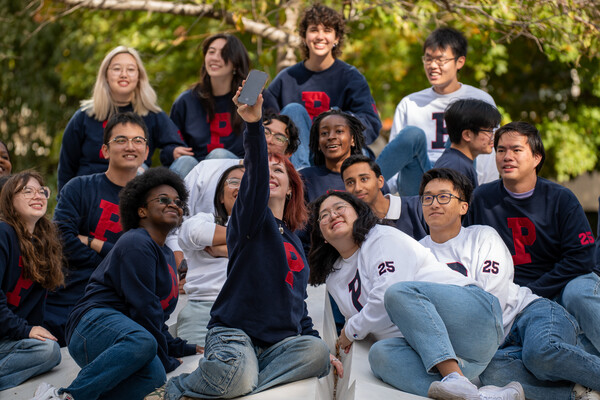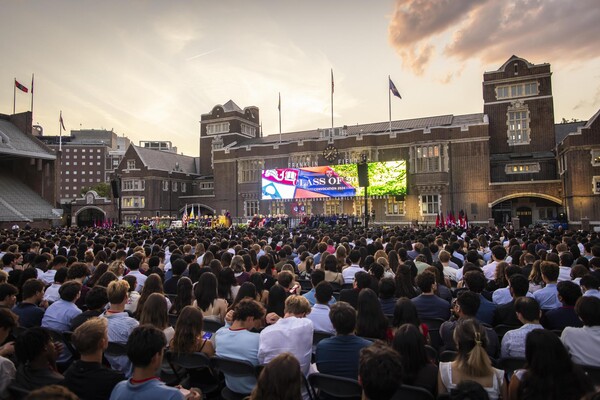A Message From President Amy Gutmann
Dear Members of our University Community:
Having just celebrated Thanksgiving, I find myself especially grateful for the privilege of working with all of you to advance Penn this year. As we rapidly approach the end of 2010, I thank every member of our community for making this a most remarkable year of achievement in our classrooms, laboratories, clinical practices, athletic fields, local community, and around the world.
In September, at Convocation on College Green, I shared my own answer to the question our Admissions Office requires every incoming freshman to answer: Why Penn? For me, it’s because Penn’s dreamers become the world’s doers. Just this year alone, members of our Penn family have inspired young minds; created art, engineering, and architectural masterpieces; developed life-saving medical treatments; nursed the sick back to health; built businesses from the ground up; and positively impacted our campus, West Philadelphia, and communities around the world. Penn’s distinctive strength is that we encourage the most passionate, talented individuals to collaborate and to put their integrated knowledge to work for humanity.
How does Penn make all of this possible? With extremely strong support from our faculty, students, staff, Trustees, Overseers, alumni, parents, and friends, we have been able to withstand the worst of the recent economic turmoil and sustain our commitment to eminence by focusing our efforts on the University’s highest priorities. Our dedicated faculty and outstanding academic programs continue to attract the world’s most talented and diverse students. This fall, Penn Admissions received the largest pool of early decision applications ever recorded by the University: 4,557 applications for the Class of 2015, representing an 18 percent increase over last year’s record numbers. The percentage of underrepresented minorities rose at an even greater rate, and the academic quality of the early decision pool is also the most impressive ever. This speaks highly of the University’s reputation among the nation’s top-ranked high school students and their keen desire to secure a place at Penn.
I know that you share my pride in our ongoing commitment to ensuring that a world-class education is affordable and attainable for all of our students, regardless of their economic circumstances. Despite a challenging environment, we have increased our financial aid budget by 78 percent over the past five years, and in this academic year the average freshman grant totals nearly $36,000. Perhaps most remarkably, as a result of our breakthrough financial aid initiatives, a Penn undergraduate education for aided students now costs on average less than it did five years ago.
We also have focused on improving access and affordability for our graduate and professional students. Graduate student stipends are up 28 percent from 2005, with the minimum stipend now reaching $20,200. Base SAS stipends (including summer stipends) are up 65 percent from 2005, now standing at $25,990.
Inside and outside the classroom, our students continue to distinguish themselves, and Penn, through extraordinary creativity, innovation, and drive. In addition to many other recognitions and prestigious awards, two of our seniors recently were awarded Marshall Scholarships. Each year, more than a thousand young men and women participate in programs or seek guidance at our Center for Undergraduate Research and Fellowships. Through work with CURF, these undergraduates become active participants in the University’s robust research enterprise and contribute to the pursuit of knowledge long before graduation. Complementing their academic prowess, our student-athletes have dominated their opponents this fall, bringing home Ivy League Championships, advancing to NCAA tournaments in men’s soccer, women’s soccer, and volleyball, and securing the Collegiate Sprint Football League Championship. Our football team also clinched the Ivy League title for the second straight season—a feat that has occurred only twice before in the 55-year history of the Ivy League. These, of course, are just a few examples of our talented students’ extraordinary achievements.
Our exceptional students deserve the best faculty, and attracting and retaining the world’s most renowned teachers and scholars remains a top priority, as does our commitment to providing critical support to all faculty as they advance interdisciplinary teaching and research. Our campus is now home to 10 Penn Integrates Knowledge (PIK) professors, and in 2010 we secured endowments for six more PIK positions. With the support of Penn Medicine, we also have five additional PIK chairs for the neurosciences, which will enable us to recruit outstanding faculty working in this pathbreaking field.
Because diversity and excellence in higher education go hand in hand, we have increased the number of underrepresented minorities among standing faculty by 22 percent, and the number of women by 10 percent, since 2005. By welcoming a spectrum of differences in cultures, backgrounds, and perspectives in every arena of the University, we are creating a community that not only respects but also celebrates the contributions that every individual makes at Penn and beyond.
In 2010, we received almost $1 billion in research awards, including $135 million in federal stimulus funding. Penn’s stimulus funding was among the highest received by any private university in the nation and reflects the remarkable strength of our faculty and research enterprise, as well as our dedication to making the world a safer and healthier place for everyone to live.
Thanks to the generous support of Penn’s many alumni and friends, our commitments to the Making History campaign now stand at $2.85 billion with an equally remarkable $2.5 billion in cash receipts. We are on track to reach our $3.5 billion goal by 2012. Even in these difficult economic times, the rate of giving to the campaign has remained high, and we are tremendously grateful for the steadfast support our donors have shown for our core priorities. Our campaign has been supported by gifts both large and small; fully one-quarter of all donations to Making History have been less than $100,000, a wonderful testament to the confidence that Penn alumni have in the bright future of their alma mater.
We have made especially strong progress in increasing the amount of student financial aid supported by the endowment. In FY2005, the undergraduate financial aid endowment generated $8.7 million in income, which represented just over 11 percent of total spending on undergraduate financial aid. In FY2011, having instituted the strongest financial aid policy in Penn’s history, the endowment provides double that proportion, 22 percent of total undergraduate aid spending, or approximately $30 million.
These past few years have been financially challenging for every institution of higher education in America, and I want to again thank the Penn community for carefully stewarding our resources. Working together, we have already saved more than $83 million in capital projects, salary and benefits costs, and reimbursable expenses. We are on track to achieve our goal of $100 million in cost-containment savings by June 30, 2011.
We must, however, remain mindful of the economic and political realities facing our nation and the Commonwealth of Pennsylvania. Governor-Elect Tom Corbett will soon be confronted with a projected $5 billion state budget deficit. The end of federal stimulus funding and pressures to control spending in Washington are likely to impact government-sponsored research funding. We must continue to exercise the prudent financial management that has been one of our core strengths.
Thanks to the strong leadership of our Office of Investments and our Investment Board, Penn's endowment has performed well. During the worst of the economic downturn in FY2009, we took proactive steps that held Penn's investment losses to 15.7 percent, as compared to a 26 percent decline in the S&P over the same period. In FY2010, we enjoyed strong performance with investment returns of 12.6 percent, which significantly exceeded our composite benchmark return of 9.0 percent. Our investment management strategies now place our returns in the top-third for large endowments over the past 10 years.
I hope all of you will take some time to walk across campus to see the inspiring physical improvements that are underway. The projects—all on budget, on schedule, and in various stages of completion—are steadily achieving the visionary goals that we established in our Penn Connects campus development strategy and our ambitious Climate Action Plan.
We recently opened the beautiful George A. Weiss Pavilion at Franklin Field. In a few months, work will begin on Shoemaker Green (the current location of our tennis courts), which will become a 3.75-acre gateway park that will link Locust Walk to the eastern edge of campus. There our 24-acre Penn Park will open next fall, creating new tennis courts, athletic fields, and elevated walkways and green spaces for the entire community to enjoy. In November, work crews installed the final steel beam in the Law School’s new Golkin Hall. The 40,000 square foot addition will include a state-of-the-art courtroom, a 350-seat auditorium, and a rooftop garden. Its scheduled completion is January 2012. In the months to come, we will break ground on the Krishna P. Singh Center for Nanotechnology on Walnut Street near 33rd Street, which will become a beautiful new eastern gateway to our campus, and we also will celebrate the opening of Penn Medicine’s revolutionary new Translational Research Center.
One year after unveiling the Climate Action Plan, we have made significant strides toward our goal to become the greenest urban campus in America. We are well along the way in increasing the green space on our campus by 20 percent. Our lovely new Horticulture Center at the Morris Arboretum is on track to receive platinum LEED certification, the highest rating possible. The Weiss Pavilion and our recently renovated Music Building are also LEED-certified buildings, as we are planning each one of our new buildings to be.
Why could Penn accomplish so much this past year, through such tough times? I have no doubt that it is because of the exceptional work that each of you does every day to advance Penn’s core missions of teaching, research, and service. Your combined and collaborative efforts distinguish Penn by producing the most innovative knowledge and putting it to work for the world. Because of these achievements, along with our fervent commitment to do even more to advance Penn’s eminence in 2011, we all can take immense pride in being part of the Penn family.
Thank you again for making my Thanksgiving especially meaningful. I wish you and your families a joyous holiday season and New Year.
Sincerely,
Amy Gutmann







